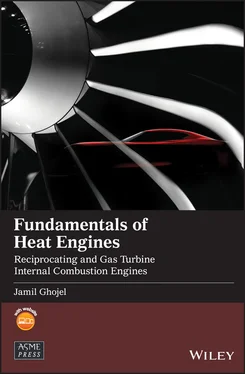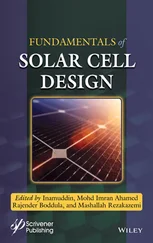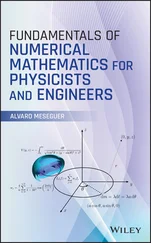Library of Congress Cataloging‐in‐Publication Data
Names: Ghojel, Jamil, author.
Title: Fundamentals of heat engines: reciprocating and gas turbine internal combustion engines / Jamil Ghojel.
Description: First edition. | Hoboken, NJ, USA : John Wiley & Sons, Inc.,
2020. | Series: Wiley-ASME press series | Includes bibliographical
references and index.
Identifiers: LCCN 2019047568 (print) | LCCN 2019047569 (ebook) | ISBN
9781119548768 (hardback) | ISBN 9781119548782 (adobe pdf) | ISBN
9781119548799 (epub)
Subjects: LCSH: Heat-engines.
Classification: LCC TJ255 .G45 2020 (print) | LCC TJ255 (ebook) | DDC
621.402/5 – dc23
LC record available at https://lccn.loc.gov/2019047568
LC ebook record available at https://lccn.loc.gov/2019047569
Cover Design: Wiley
Cover Images: Turbine Blades © serts/Getty Images, Rad sports car silhouette © Arand/Getty Images
The Wiley‐ASME Press Series in Mechanical Engineering brings together two established leaders in mechanical engineering publishing to deliver high‐quality, peer‐reviewed books covering topics of current interest to engineers and researchers worldwide.
The series publishes across the breadth of mechanical engineering, comprising research, design and development, and manufacturing. It includes monographs, references and course texts.
Prospective topics include emerging and advanced technologies in Engineering Design; Computer‐Aided Design; Energy Conversion & Resources; Heat Transfer; Manufacturing & Processing; Systems & Devices; Renewable Energy; Robotics; and Biotechnology.
The reciprocating piston engine and the gas turbine engine are two of the most vital and widely used internal combustion heat engines ever invented. Piston engines are still dominant in the areas of land and marine transportation, mining, and agricultural industries. They also play a significant role in light aircraft and stand‐by power‐generation applications. Power that can be generated by piston engines ranges from a fraction of a kilowatt to more than 80 MW , with thermal efficiencies approaching 50%. Gas turbines are dominant in civil and military aviation and play a major role in base, midrange, and peak load electric power generation ranging from small stand‐by units up to 300 MW per engine with thermal efficiencies approaching 40% at the upper range and 500 MW in combined cycle configurations with thermal efficiencies approaching 60%. Gas turbines are also ideal as power plants operating in conjunction with large renewable power plants to eliminate intermittency.
Demand for power and mobility in its different forms will continue to increase in the twenty‐first century as hundreds of millions of people in the developing world become more affluent, and the cheapest and most efficient means of satisfying this demand will continue to be the heat engine. As a consequence, the heat engine will most likely remain an active area of research and development and engineering education for the foreseeable future. Traditionally, the piston engine has been an ideal tool for teaching mechanical engineering, as it features fundamental principles of the engineering sciences such as thermodynamics, engineering mechanics, fluid mechanics, chemistry (more specifically, thermochemistry), etc. In this book, gas turbine engine theory, which is based on the same engineering principles, is combined with piston engine theory to form a single comprehensive tool for teaching mechanical, aerospace, and automotive engineering in entry‐ and advanced‐level undergraduate courses and entry‐level energy‐related postgraduate courses. Practicing engineers in industry may also find some of the material in the book beneficial.
The book comprises 3 parts, 15 chapters, and 4 appendices. The first chapter in Part I is a review of some principles of engineering science, and the second chapter covers a wide range of thermochemistry topics. The contribution of engineering science to heat engine theory is fundamental and is manifested over the entire energy‐conversion chain, as this figure shows.

Part II covers theoretical aspects of the reciprocating piston engine starting with simple air‐standard cycles, followed by theoretical cycles of forced induction engines and ending with more realistic cycles that can be used to predict engine performance as a first approximation. Part III on gas turbines also covers cycles with gradually increasing complexity, ending with realistic engine design‐point and off‐design calculation methods.
Representative problems are given at the end of each chapter, and a detailed example of piston‐engine design‐point calculations is given in Appendix C. Also, case studies of design‐point calculations of gas turbine engines are provided in Chapters 12and 13.
The book can be adopted for mechanical, aerospace, and automotive engineering courses at different levels using selected material from different chapters at the discretion of instructors.
Jamil Ghojel
A Area, air, Helmholtz function a Acceleration, speed of sound, correlation coefficient B Bulk modulus, correlation coefficient, bypass ratio C Gas velocity, molar specific heat c Mass specific heat, speed of sound D Diameter, degree of reaction in reaction turbines E Total energy, utilization factor in reaction turbines, modulus of elasticity F Force, thrust, fuel f Specific thrust G Gibbs free energy g Gravitational acceleration H Enthalpy, heating value of fuel h Specific enthalpy, blade height I Moment of inertiaiNumber of cylindersjNumber of strokes K Degrees Kelvin, equilibrium constant, force, mole ratio of hydrogen to carbon monoxide L Length l Length, blade length M Quantity in moles, Mach number, moment of force m Mass  Mass flow rate N Rotational speed in revolution per minute, force n Polytropic index (exponent), number of moles p Pressure, cylinder gas pressure Q Heat transfer, force q Specific heat transfer
Mass flow rate N Rotational speed in revolution per minute, force n Polytropic index (exponent), number of moles p Pressure, cylinder gas pressure Q Heat transfer, force q Specific heat transfer  Rate of heat transfer R Radius, gas constant, crank radius
Rate of heat transfer R Radius, gas constant, crank radius  Universal gas constant r Pressure ratio S Entropy, stroke s Specific entropy T Absolute temperature, torque, fundamental dimension of time t Time, temperature U Internal energy, blade speed u Specific internal energy V Volume, velocity, relative velocity v Specific volume, piston speed W Work
Universal gas constant r Pressure ratio S Entropy, stroke s Specific entropy T Absolute temperature, torque, fundamental dimension of time t Time, temperature U Internal energy, blade speed u Specific internal energy V Volume, velocity, relative velocity v Specific volume, piston speed W Work  Power w Specific work, blade row width, rate of heat release x Distance, mass fraction, number of carbon atoms in a fuel, cumulative heat release
Power w Specific work, blade row width, rate of heat release x Distance, mass fraction, number of carbon atoms in a fuel, cumulative heat release  Linear velocity
Linear velocity  Linear accelerationyNumber of hydrogen atoms in a fuelzNumber of oxygen atoms in a fuel, height above datum
Linear accelerationyNumber of hydrogen atoms in a fuelzNumber of oxygen atoms in a fuel, height above datum
Читать дальше


 Mass flow rate N Rotational speed in revolution per minute, force n Polytropic index (exponent), number of moles p Pressure, cylinder gas pressure Q Heat transfer, force q Specific heat transfer
Mass flow rate N Rotational speed in revolution per minute, force n Polytropic index (exponent), number of moles p Pressure, cylinder gas pressure Q Heat transfer, force q Specific heat transfer  Rate of heat transfer R Radius, gas constant, crank radius
Rate of heat transfer R Radius, gas constant, crank radius  Universal gas constant r Pressure ratio S Entropy, stroke s Specific entropy T Absolute temperature, torque, fundamental dimension of time t Time, temperature U Internal energy, blade speed u Specific internal energy V Volume, velocity, relative velocity v Specific volume, piston speed W Work
Universal gas constant r Pressure ratio S Entropy, stroke s Specific entropy T Absolute temperature, torque, fundamental dimension of time t Time, temperature U Internal energy, blade speed u Specific internal energy V Volume, velocity, relative velocity v Specific volume, piston speed W Work  Power w Specific work, blade row width, rate of heat release x Distance, mass fraction, number of carbon atoms in a fuel, cumulative heat release
Power w Specific work, blade row width, rate of heat release x Distance, mass fraction, number of carbon atoms in a fuel, cumulative heat release  Linear velocity
Linear velocity  Linear accelerationyNumber of hydrogen atoms in a fuelzNumber of oxygen atoms in a fuel, height above datum
Linear accelerationyNumber of hydrogen atoms in a fuelzNumber of oxygen atoms in a fuel, height above datum








